Xiaotian Zhang
Med-U1: Incentivizing Unified Medical Reasoning in LLMs via Large-scale Reinforcement Learning
Jun 14, 2025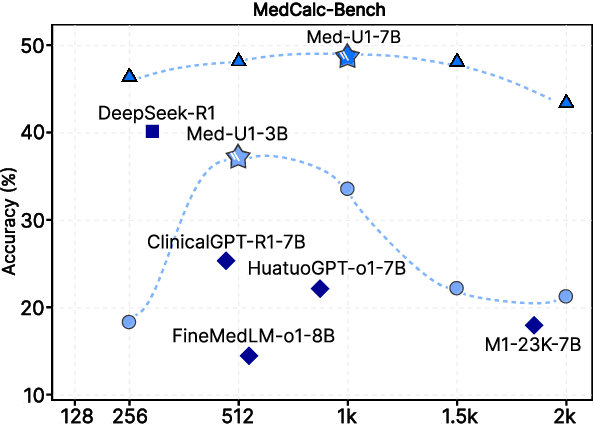
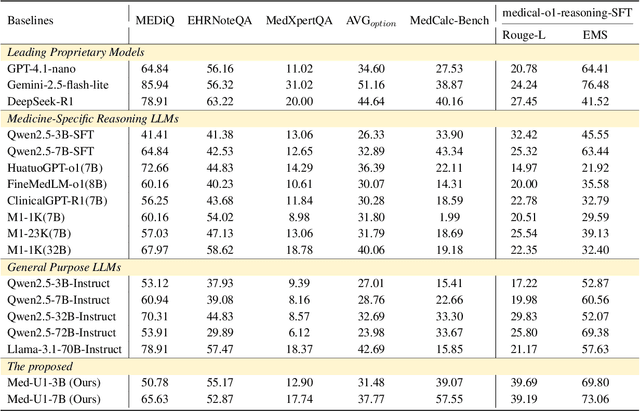
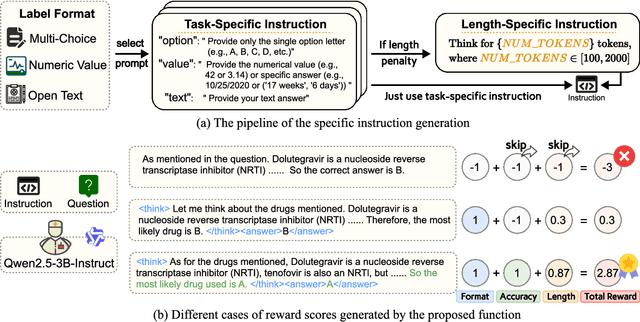

Abstract:Medical Question-Answering (QA) encompasses a broad spectrum of tasks, including multiple choice questions (MCQ), open-ended text generation, and complex computational reasoning. Despite this variety, a unified framework for delivering high-quality medical QA has yet to emerge. Although recent progress in reasoning-augmented large language models (LLMs) has shown promise, their ability to achieve comprehensive medical understanding is still largely unexplored. In this paper, we present Med-U1, a unified framework for robust reasoning across medical QA tasks with diverse output formats, ranging from MCQs to complex generation and computation tasks. Med-U1 employs pure large-scale reinforcement learning with mixed rule-based binary reward functions, incorporating a length penalty to manage output verbosity. With multi-objective reward optimization, Med-U1 directs LLMs to produce concise and verifiable reasoning chains. Empirical results reveal that Med-U1 significantly improves performance across multiple challenging Med-QA benchmarks, surpassing even larger specialized and proprietary models. Furthermore, Med-U1 demonstrates robust generalization to out-of-distribution (OOD) tasks. Extensive analysis presents insights into training strategies, reasoning chain length control, and reward design for medical LLMs. The code will be released.
Is Grokking a Computational Glass Relaxation?
May 16, 2025Abstract:Understanding neural network's (NN) generalizability remains a central question in deep learning research. The special phenomenon of grokking, where NNs abruptly generalize long after the training performance reaches a near-perfect level, offers a unique window to investigate the underlying mechanisms of NNs' generalizability. Here we propose an interpretation for grokking by framing it as a computational glass relaxation: viewing NNs as a physical system where parameters are the degrees of freedom and train loss is the system energy, we find memorization process resembles a rapid cooling of liquid into non-equilibrium glassy state at low temperature and the later generalization is like a slow relaxation towards a more stable configuration. This mapping enables us to sample NNs' Boltzmann entropy (states of density) landscape as a function of training loss and test accuracy. Our experiments in transformers on arithmetic tasks suggests that there is NO entropy barrier in the memorization-to-generalization transition of grokking, challenging previous theory that defines grokking as a first-order phase transition. We identify a high-entropy advantage under grokking, an extension of prior work linking entropy to generalizability but much more significant. Inspired by grokking's far-from-equilibrium nature, we develop a toy optimizer WanD based on Wang-landau molecular dynamics, which can eliminate grokking without any constraints and find high-norm generalizing solutions. This provides strictly-defined counterexamples to theory attributing grokking solely to weight norm evolution towards the Goldilocks zone and also suggests new potential ways for optimizer design.
Persona-judge: Personalized Alignment of Large Language Models via Token-level Self-judgment
Apr 17, 2025Abstract:Aligning language models with human preferences presents significant challenges, particularly in achieving personalization without incurring excessive computational costs. Existing methods rely on reward signals and additional annotated data, limiting their scalability and adaptability to diverse human values. To address these challenges, we introduce Persona-judge, a novel discriminative paradigm that enables training-free personalized alignment with unseen preferences. Instead of optimizing policy parameters through external reward feedback, Persona-judge leverages the intrinsic preference judgment capabilities of the model. Specifically, a draft model generates candidate tokens conditioned on a given preference, while a judge model, embodying another preference, cross-validates the predicted tokens whether to be accepted. Experimental results demonstrate that Persona-judge, using the inherent preference evaluation mechanisms of the model, offers a scalable and computationally efficient solution to personalized alignment, paving the way for more adaptive customized alignment.
High-entropy Advantage in Neural Networks' Generalizability
Mar 17, 2025Abstract:While the 2024 Nobel Prize in Physics ignites a worldwide discussion on the origins of neural networks and their foundational links to physics, modern machine learning research predominantly focuses on computational and algorithmic advancements, overlooking a picture of physics. Here we introduce the concept of entropy into neural networks by reconceptualizing them as hypothetical physical systems where each parameter is a non-interacting 'particle' within a one-dimensional space. By employing a Wang-Landau algorithms, we construct the neural networks' (with up to 1 million parameters) entropy landscapes as functions of training loss and test accuracy (or loss) across four distinct machine learning tasks, including arithmetic question, real-world tabular data, image recognition, and language modeling. Our results reveal the existence of \textit{entropy advantage}, where the high-entropy states generally outperform the states reached via classical training optimizer like stochastic gradient descent. We also find this advantage is more pronounced in narrower networks, indicating a need of different training optimizers tailored to different sizes of neural networks.
DiffPO: Diffusion-styled Preference Optimization for Efficient Inference-Time Alignment of Large Language Models
Mar 06, 2025Abstract:Inference-time alignment provides an efficient alternative for aligning LLMs with humans. However, these approaches still face challenges, such as limited scalability due to policy-specific value functions and latency during the inference phase. In this paper, we propose a novel approach, Diffusion-styled Preference Optimization (\model), which provides an efficient and policy-agnostic solution for aligning LLMs with humans. By directly performing alignment at sentence level, \model~avoids the time latency associated with token-level generation. Designed as a plug-and-play module, \model~can be seamlessly integrated with various base models to enhance their alignment. Extensive experiments on AlpacaEval 2, MT-bench, and HH-RLHF demonstrate that \model~achieves superior alignment performance across various settings, achieving a favorable trade-off between alignment quality and inference-time latency. Furthermore, \model~demonstrates model-agnostic scalability, significantly improving the performance of large models such as Llama-3-70B.
Exploring Intrinsic Normal Prototypes within a Single Image for Universal Anomaly Detection
Mar 04, 2025Abstract:Anomaly detection (AD) is essential for industrial inspection, yet existing methods typically rely on ``comparing'' test images to normal references from a training set. However, variations in appearance and positioning often complicate the alignment of these references with the test image, limiting detection accuracy. We observe that most anomalies manifest as local variations, meaning that even within anomalous images, valuable normal information remains. We argue that this information is useful and may be more aligned with the anomalies since both the anomalies and the normal information originate from the same image. Therefore, rather than relying on external normality from the training set, we propose INP-Former, a novel method that extracts Intrinsic Normal Prototypes (INPs) directly from the test image. Specifically, we introduce the INP Extractor, which linearly combines normal tokens to represent INPs. We further propose an INP Coherence Loss to ensure INPs can faithfully represent normality for the testing image. These INPs then guide the INP-Guided Decoder to reconstruct only normal tokens, with reconstruction errors serving as anomaly scores. Additionally, we propose a Soft Mining Loss to prioritize hard-to-optimize samples during training. INP-Former achieves state-of-the-art performance in single-class, multi-class, and few-shot AD tasks across MVTec-AD, VisA, and Real-IAD, positioning it as a versatile and universal solution for AD. Remarkably, INP-Former also demonstrates some zero-shot AD capability. Code is available at:https://github.com/luow23/INP-Former.
PAD: Personalized Alignment at Decoding-Time
Oct 14, 2024



Abstract:Aligning with personalized preferences, which vary significantly across cultural, educational, and political differences, poses a significant challenge due to the computational costs and data demands of traditional alignment methods. In response, this paper presents Personalized Alignment at Decoding-time (PAD), a novel framework designed to align LLM outputs with diverse personalized preferences during the inference phase, eliminating the need for additional training. By introducing a unique personalized reward modeling strategy, this framework decouples the text generation process from personalized preferences, facilitating the generation of generalizable token-level personalized rewards. The PAD algorithm leverages these rewards to guide the decoding process, dynamically tailoring the base model's predictions to personalized preferences. Extensive experimental results demonstrate that PAD not only outperforms existing training-based alignment methods in terms of aligning with diverse preferences but also shows significant generalizability to preferences unseen during training and scalability across different base models. This work advances the capability of LLMs to meet user needs in real-time applications, presenting a substantial step forward in personalized LLM alignment.
Does Correction Remain A Problem For Large Language Models?
Aug 14, 2023Abstract:As large language models, such as GPT, continue to advance the capabilities of natural language processing (NLP), the question arises: does the problem of correction still persist? This paper investigates the role of correction in the context of large language models by conducting two experiments. The first experiment focuses on correction as a standalone task, employing few-shot learning techniques with GPT-like models for error correction. The second experiment explores the notion of correction as a preparatory task for other NLP tasks, examining whether large language models can tolerate and perform adequately on texts containing certain levels of noise or errors. By addressing these experiments, we aim to shed light on the significance of correction in the era of large language models and its implications for various NLP applications.
Multijugate Dual Learning for Low-Resource Task-Oriented Dialogue System
May 25, 2023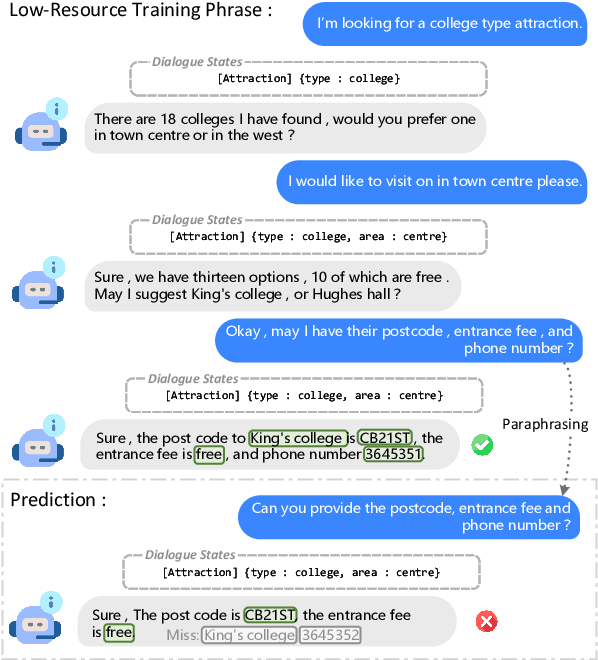
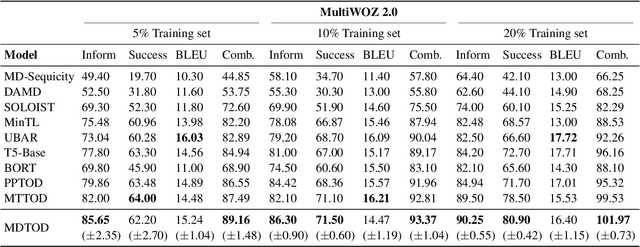
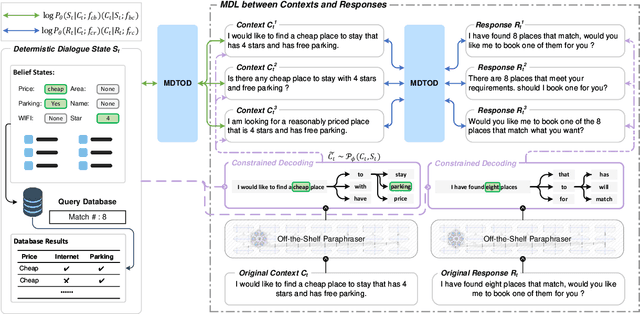

Abstract:Dialogue data in real scenarios tend to be sparsely available, rendering data-starved end-to-end dialogue systems trained inadequately. We discover that data utilization efficiency in low-resource scenarios can be enhanced by mining alignment information uncertain utterance and deterministic dialogue state. Therefore, we innovatively implement dual learning in task-oriented dialogues to exploit the correlation of heterogeneous data. In addition, the one-to-one duality is converted into a multijugate duality to reduce the influence of spurious correlations in dual training for generalization. Without introducing additional parameters, our method could be implemented in arbitrary networks. Extensive empirical analyses demonstrate that our proposed method improves the effectiveness of end-to-end task-oriented dialogue systems under multiple benchmarks and obtains state-of-the-art results in low-resource scenarios.
Evaluating the Performance of Large Language Models on GAOKAO Benchmark
May 23, 2023Abstract:Large language models have demonstrated remarkable performance across various natural language processing tasks; however, their efficacy in more challenging and domain-specific tasks remains less explored. This paper introduces the GAOKAO-Benchmark (GAOKAO-Bench), an intuitive benchmark that employs questions from the Chinese Gaokao examination as test samples for evaluating large language models.In order to align the evaluation results with humans as much as possible, we designed a method based on zero-shot prompts to analyze the accuracy and scoring rate of the model by dividing the questions into subjective and objective types. We evaluated the ChatGPT model on GAOKAO-Benchmark performance.Our findings reveal that the ChatGPT model excels in tackling objective questions, while also shedding light on its shortcomings and areas for improvement. To further scrutinize the model's responses, we incorporate human evaluations.In conclusion, this research contributes a robust evaluation benchmark for future large-scale language models and offers valuable insights into the limitations of such models.
 Add to Chrome
Add to Chrome Add to Firefox
Add to Firefox Add to Edge
Add to Edge